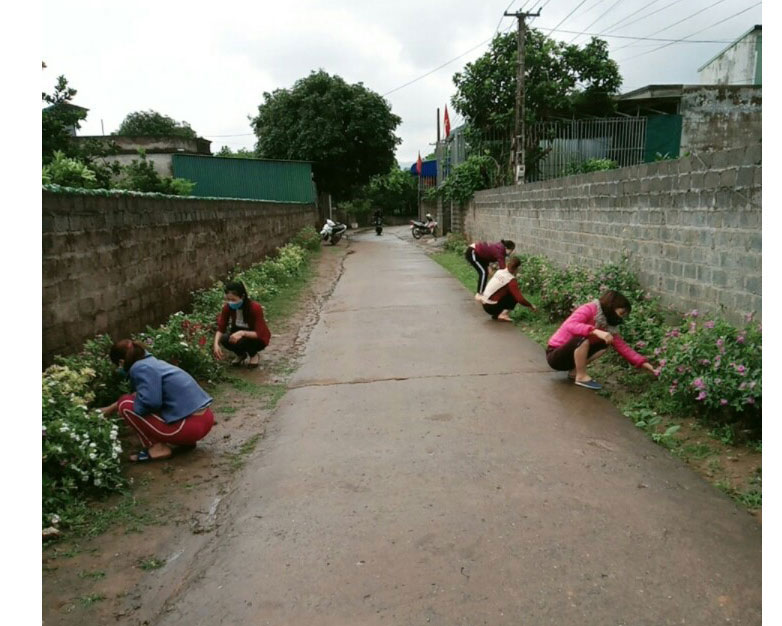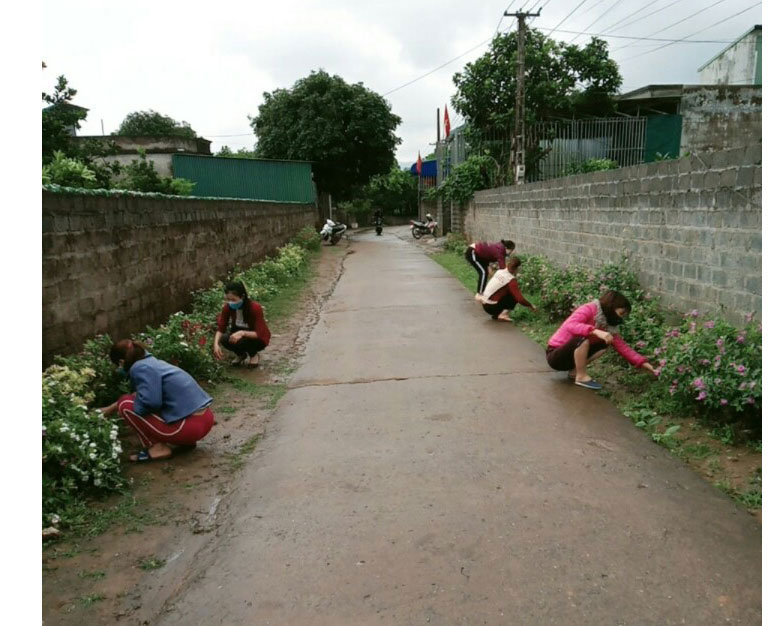
(HBO) - In recent years, the movement "All people unite to build a cultural life” in Nam Phong commune (Cao Phong) has been actively and effectively implemented. The economy has been developing and the rural face has constantly been renewed, contributing to improving the cultural and spiritual life for the People.
 The women in Nam Thai hamlet, Nam Phong commune (Cao Phong) are taking care of the flower roads, creating a clean and beautiful landscape in the area.
The women in Nam Thai hamlet, Nam Phong commune (Cao Phong) are taking care of the flower roads, creating a clean and beautiful landscape in the area.
Mr. Dinh Duc Lam, the Vice Chairman of the People's Committee of Nam Phong Commune says: Currently, there are 9 hamlets, 1,056 households, with over 4,500 people in the commune. Determining that the implementation of the movement "All people unite to build a cultural life” is a driving force for the socio-economic development at the locality, the Party Committee and the authorities of the commune have actively implemented many contents and activities, aiming to promote the movement associated with the implementation of building new rural areas, gradually improving the quality of cultural and spiritual life for the People.
The criteria of the movement to build cultural families, villages and residential areas have been deployed to each hamlet and village so that the people can understand and implement them. The registration, the review and the proposal for the recognition of the cultural families are made publicly and in accordance with the standards. Up to now, nearly 90% of the households in the whole commune have been recognized a title of a cultural family and 7 out of the 9 hamlets have been granted the title of the cultural village, in which Nam Thai hamlet has been selected to build a model of the residential area; 100% of the hamlets have their own cultural houses, playgrounds and training grounds so that the people can participate in cultural and sports activities.
With these achievements, the movement "All people unite to build a cultural life” has really been spreading widely to all classes of people, creating a lively atmosphere in all residential areas, becoming a great source of motivation and contribution in fulfilling the targets of socio-economic development, and making Nam Phong increasingly develop.
With an increasingly vibrant and widespread emulation movement aimed at building cultured residential areas and cultured families, Yen Thuy District has been making steady progress toward improving both the material and spiritual well-being of its people, while fostering a civilized, prosperous, beautiful, and progressive community.
Once lacking recreational spaces and community facilities, Residential Group 2 in Quynh Lam Ward (Hoa Binh City) has recently received attention for the construction of a new, spacious, and fully equipped cultural house. The project followed the model of state support combined with public contributions in both labor and funding.
The "All people unite to build cultural life" movement, which has been effectively integrated with Kim Boi district’s socio-economic development goals, is fostering a lively spirit of emulation across local residential areas, hamlets, villages, public agencies, and enterprises. In addition, through the initiative, traditional cultural values are being preserved and promoted, while community solidarity and mutual support in poverty reduction and economic development are being strengthened.
A working delegation of the Hoa Binh provincial People’s Committee led by its Permanent Vice Chairman Nguyen Van Toan on June 11 inspected the progress of a project to build the Mo Muong Cultural Heritage Conservation Space linked to tourism services in Hop Phong commune, Cao Phong district.
Born and growing in the heroic land of Muong Dong, Dinh Thi Kieu Dung, a resident in Bo town of Kim Boi district, in her childhood was nurtured by the sweet lullabies of her grandmother and mother. These melodies deeply imprinted on her soul, becoming an inseparable part of her love for her ethnic group's culture. For over 20 years, this love for her hometown has driven Dung to research, collect, and pass down the cultural values of the Muong people to future generations.
In the final days of May, the Ethnic Art Troupe of Hoa Binh Province organized performances to serve the people in remote, mountainous, and particularly disadvantaged areas within the province. These were not just ordinary artistic shows, but they were the meaningful journeys aimed at spreading cultural values, enhancing the spiritual life of the people and contributing to the preservation of ethnic minority cultural identities.



 The women in Nam Thai hamlet, Nam Phong commune (Cao Phong) are taking care of the flower roads, creating a clean and beautiful landscape in the area.
The women in Nam Thai hamlet, Nam Phong commune (Cao Phong) are taking care of the flower roads, creating a clean and beautiful landscape in the area.